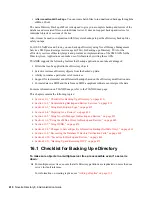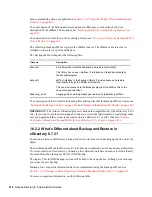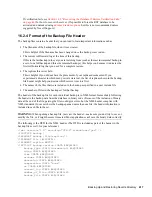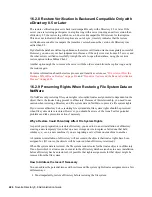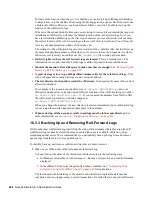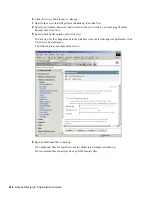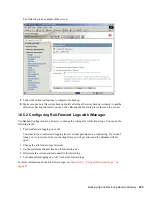
422
Novell eDirectory 8.8 Administration Guide
no
vd
ocx
(e
n)
6 Ap
ril 20
07
Restoring file sys:/system/nici/XMGRCFG.NIF
Database restore finished
Completion time 00:00:15
Restore completed successfully
16.2.6 Using DSMASTER Servers as Part of Disaster Recovery
Planning
If you have a multiple-server environment and want to plan for recovery after a disaster in which all
your servers are lost, you can use DSMASTER servers as part of the plan for your tree.
The Backup eMTool is used to back up each server separately; it is server-centric, not tree-centric.
However, if you create DSMASTER servers, you can use Backup eMTool functionality specifically
to back up your whole tree structure. An example of this strategy is outlined in
“Scenario: Losing
All Servers in a Multiple-Server Environment” on page 470
.
When restoring after a disaster, one of the main concerns is how to avoid restoring replicas of the
same partition that are inconsistent with each other. If you lose roll-forward logs for your servers as
part of a disaster, you won't be able to restore all your servers to the same moment in time. Without
the roll-forward logs, the replicas you have in your backups are inconsistent with each other and
would cause problems if they were all restored and brought into the tree together. (The restore
verification process is designed to help prevent these problems; by default a restored eDirectory
database will not open after the restore if it is inconsistent with the other replicas.)
You can use DSMASTER servers to help you prepare for this issue, by creating a master copy of
your tree that you could use as a starting point.
To use DSMASTER servers to help prepare for a disaster:
Plan your replicas so that you have one server that contains a replica of every partition in your
tree, so a copy of the whole tree is in the eDirectory database on one server (or, if your tree is
large, you can use a couple of key servers). This kind of server is often called a DSMASTER
server. The replicas on the DSMASTER server should be master or read/write replicas.
NOTE:
If a couple of key DSMASTER servers are used instead of just one, keep in mind that
ideally each DSMASTER server should have a unique set of replicas of partitions. There
should be no overlap between them, to avoid inconsistencies between the replicas when
restoring after a disaster.
If your servers were lost in a disaster, you would not have access to the most recent roll-
forward logs for restoring because roll-forward logs are saved locally on the server, so all the
DSMASTER servers probably could not be restored to the same moment in time. If the same
replica were held on two DSMASTER servers, the two copies would probably not be identical
and would cause inconsistencies in the tree. So, for disaster recovery planning it's best to not
have the same partition replicated on more than one DSMASTER server.
For general information on replicas, see
Section 1.6, “Replicas,” on page 54
.
Back up these DSMASTER servers regularly to create a backup copy of your tree. You might
want to take extra precautions for storing the backups of DSMASTER servers as part of your
disaster recovery plan.
Summary of Contents for EDIRECTORY 8.8 SP2
Page 4: ...novdocx en 6 April 2007...
Page 116: ...116 Novell eDirectory 8 8 Administration Guide novdocx en 6 April 2007...
Page 128: ...128 Novell eDirectory 8 8 Administration Guide novdocx en 6 April 2007...
Page 255: ...256 Novell eDirectory 8 8 Administration Guide novdocx en 6 April 2007...
Page 406: ...408 Novell eDirectory 8 8 Administration Guide novdocx en 6 April 2007...
Page 563: ...566 Novell eDirectory 8 8 Administration Guide novdocx en 6 April 2007...
Page 573: ...576 Novell eDirectory 8 8 Administration Guide novdocx en 6 April 2007...
Page 601: ...604 Novell eDirectory 8 8 Administration Guide novdocx en 6 April 2007...



